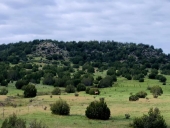Connie Johnson wrote:There is a seasonal creek but no standing water we can see. This year the snowfall was well above average and record rainfall this Spring and no flooding. NO swampy or boggy areas.
You can tell whether water sometimes stands by what trees, grasses and other plants grow in an area. For example, in SE Oklahoma and parts of Texas, native persimmon trees thrive where water stands, but the pecan trees that grow near them thrive just beyond where the water stands.
So picture a wet-weather creek flowing through a property. Where the persimmon trees are is where the water stands. Just a little further from the creek (a few feet to a few dozen feet) is where the pecan trees grow. (These are trees that planted themselves by their seeds floating down the creek.)
When man-made ponds overflow, water spreads in a particular area. Some of it stands in water a lot. Where the water does not stand, the persimmon trees are not spreading. Where the water DOES stand for weeks on end, persimmon trees are popping up everywhere. So are wild grapes.
Some grasses and plants grow best where the soil stays wet and others will not grow where water stands. Become familiar with which is which and when you look at property you can tell what the patterns are during seasons when you aren't there to look.
Note which trees and plants grow along fence lines where it is wetter and where it isn't. Those are planted by birds sitting on the fences. Some will only grow where water stands or water runs off the property into the bar ditch (manmade channels on each side of roads so that water runs away from the road).
Others will grow anywhere along a fence line. That indicates that they don't need as much water.






